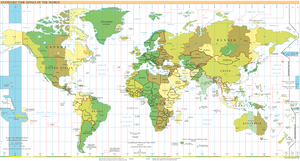UTC−10:00
In today's world, UTC−10:00 is a topic of great relevance and interest to a wide variety of people. Whether due to its impact on society, its historical relevance or its importance today, UTC−10:00 has become a topic that leaves no one indifferent. From its origins to its influence today, UTC−10:00 has been the subject of in-depth analysis by experts in different disciplines, who seek to better understand its nature and its impact in various areas. In this article, we will explore some of the most relevant facets of UTC−10:00 and its importance in today's world.
This article needs additional citations for verification. (December 2009) |
| UTC−10:00 | |
|---|---|
| Time zone | |
 World map with the time zone highlighted | |
| UTC offset | |
| UTC | UTC−10:00 |
| Current time | |
| 15:36, 1 May 2024 UTC−10:00 | |
| Central meridian | |
| 150 degrees W | |
| Date-time group | |
| W | |

UTC−10:00 is an identifier for a time offset from UTC of −10:00. This time is used in Hawaii, Alaska, French Polynesia, and the Cook Islands.
As standard time (year-round)
Principal cities: Honolulu, Avarua, Papeete, Fa'a'ā
Oceania
Pacific Ocean
Polynesia
- France
- French Polynesia
- Society Islands
- Tuamotus
- Disappointment Islands
- Duke of Gloucester Islands
- Far East Tuamotu Group
- Hao Group
- Hikeru Group
- King George Islands
- Palliser Islands
- Raeffsky Islands
- Gambier Islands
- Outer Gambier Group
- Acteon Group
- Austral Islands
- Tupua'i Islands
- Bass Islands
- French Polynesia
- New Zealand
- United States (Hawaii–Aleutian Time Zone)
As standard time (Northern Hemisphere winter)
North America
- United States
- Alaska
- Aleutian Islands west of 169.30°W
- Alaska
Historical changes
- Kiribati
- Line Islands – including Kiritimati (Christmas Island) advanced 24 hours (to UTC+14:00) to the eastern hemisphere side of the International Date Line by skipping December 31, 1994.
- Samoa – Time in Samoa advanced 24 hours (to UTC+14:00) to the eastern hemisphere side of the International Date Line by skipping December 30, 2011.
References
- ^ "Time Zone Abbreviations: CKT". Archived from the original on 2019-12-16. Retrieved 2015-02-16.